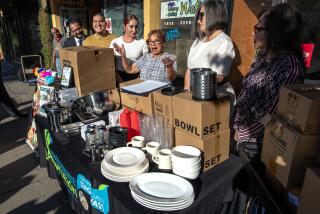Restaurants get a little greener
When Neal and Amy Knoll Fraser move their restaurant Grace downtown to the rectory of St. Vibiana’s later this year, diners will be hard-pressed to miss the earth-to-table connection.
Fraser intends to plant a garden — and not just a few containers of herbs, but 450 to 500 square feet, right outside, cater-corner from Los Angeles Police Department headquarters. It will be tended by the kitchen staff, and Fraser says it could yield as much as a quarter of the produce for his kitchen. He’s eyeing a parking lot for more garden space.
As they renovate the rectory — more than a century old, with hand-painted ceilings and arched walkways — to build a 100-seat restaurant with patio dining, an upstairs bar and four private dining rooms, they plan to use paints with low or no volatile organic compounds, to install cisterns so water from designated prep sinks can irrigate the garden. And they’ll make compost. Fraser has an idea for taking diners into the garden to pick, say, five ingredients for a tasting menu.
The couple were early converts to making their restaurants, Grace and BLD, both now on Beverly Boulevard, green. At Grace, they filter the water and offer it without charge. Grace’s used oil is recycled to run a family car. They persuaded a fish supplier to switch to reusable bins.
Fraser says he was inspired by the birth of their daughter five years ago: “I looked outside, and saw, how is she going to live?”
“We really do have to take this seriously and do as much as we can. It’s so difficult. Everyone is busy, and operating a restaurant is not a piece of cake,” Knoll Fraser says.
Whether for the bottom line or for the highest of ideals, more restaurateurs are working toward “sustainability.” There’s no legal definition for a sustainable restaurant, but sustainability — in restaurants, economies or relationships — generally means serving the needs of the present while preserving the ability to meet the needs of the future.
Chefs often take that to mean using locally grown produce, buying supplies from companies that respect the environment and encouraging frugal practices in their kitchens. By turning off lights, installing water filtration systems, recycling cooking oil for biodiesel and using hybrid vehicles for delivery, owners have branched out from just buying chickens that toddle free around a farm.
“There are thousands of restaurants who have owners who believe they need to do their part,” says Joel Makower, executive editor of the online publishing company GreenBiz.com.
Matt Lyman takes his restaurants’ carbon footprint very seriously, all the way to the gloves.
The staff at Tender Greens, a small, salad-centric chain of restaurants that Lyman owns with two partners, mixes salads by hand in front of diners, wearing disposable gloves — lots of them — that end up in landfills. He’d like to find some that could be recycled or composted.
“I have everyone I know trying to source them. If enough people ask, someone will come up with them,” says Lyman, who has worked hard to make as many environmentally friendly choices as possible in the restaurants in San Diego, Culver City, West Hollywood and Hollywood.
Until then, Lyman says that despite any amount of hand-washing, customers are reassured by the gloves, and tongs are a nonstarter.
“Tongs break up the lettuce and kind of destroy the essence of what makes our food so good,” he says.
Lyman and his partners have, however, solved many problems. They plan soon to dispense with soda bottles by making their own beverages using fruits in season — pear or apple soda in the fall, blood orange in the winter. All year, they’ll serve ginger and lemon-lime.
They bought some old bleachers in Ukiah and turned them into a counter in the West Hollywood restaurant. The staff uniforms are organic cotton T-shirts. They serve high-quality fast food, and buy produce from local growers such as Scarborough Farms in Oxnard.
Both Grace and Tender Greens have plenty of company. In the last few years, there’s been a blossoming attitude that it’s not enough to serve food that tastes good, at a good price, in a comfortable dining room.
Ryan Ballinger opened the York, a 99-seat gastropub in Highland Park, reusing as much of what he found in the building as possible. He also put in tables made from pressed recycled paper, and a long window counter made of recycled wood. He estimates he recycles about 70% of his kitchen oil, glass and paper and food waste. He doesn’t print menus; they’re written on chalkboards around the bar.
“Some of that is just ingrained in you, you don’t want to be wasteful,” Ballinger says. “Waste is loss, essentially. That’s just a business perspective.”
It’s not just the little guys who are doing it, either. Steve Ells, who started the nearly 1,000-outlet Chipotle chain with one restaurant 17 years ago, took his experience working for Jeremiah Tower at Stars in San Francisco to a fast food restaurant.
“I thought we were doing something really good by serving this fresh food. And we were doing something good. It was fresh, it wasn’t processed,” Ells says.
Then, he says, he visited a pig farm.
“What I saw was horrifying,” Ells says, describing it as “real exploitation, terrible exploitation of the animals in terms of their well-being, exploitation of the land. Factory farms pollute, they smell.”
Ells made a decision: “I did not want my success to be based on this kind of exploitation.”
Chipotle now buys pork from a cooperative of small farmers, and it is beginning to buy dairy products from places where the animals are pasture-raised, he says.
For independent eateries, greening still seems concentrated in hipper, more affluent neighborhoods.
“So many restaurants are just trying to stay in business,” says Colleen Oteri, spokeswoman for the Boston-based Green Restaurant Assn., which issues certifications based on a point system in categories such as food, waste and building materials. “They’re just trying to have customers at the door everyday. ‘If it’s not broken, don’t fix it’ kind of thing.”
The association, founded in 1990, has certified 265 restaurants around the country, with an additional 400 in the process.
Even for entrepreneurs committed to environmentalism, it can be difficult to figure out what to do, and costly to do it. Are compostable takeout containers better than those that can be recycled if the customer doesn’t compost them? Installing a water filtration system does away with bottles — but also with the profit bottled water brings.
Leslie VanKeuren, the former manager of Gingergrass in Silver Lake and now a sustainability consultant, offers some cost-free suggestions. Use cloths from the hamper to wipe up spills rather than reaching for paper towels. And switch to “inquire versus include” for takeout orders. For example, at Gingergrass, takeout diners were asked whether they needed utensils, and if so, how many and what sort. Chopsticks or forks? Need a soup spoon?
Santa Monica has a green certification program, and this summer, restaurants and other businesses should be able to apply for L.A.’s green certification program. Close to 800 restaurants, as varied as Jack in the Box and Campanile, take part in a city recycling program that has diverted 55,000 tons of food waste from landfills to compost, says Zafar Karimi, manager of the program for the Bureau of Sanitation. But with more than 8,000 food service businesses in the city, Karimi says, there’s a long way to go.
Comme Ca on Melrose Avenue turns over used grease to Further, a company that extracts the glycerin to make soap — for the restrooms, the dishes and the kitchen staff, says Dong Choi, the executive chef. They plan to do the same thing at their Costa Mesa restaurant, Pizzeria Ortica.
The recession inspired an extra bit of frugality at Comme Ca: Customers who order the popular roast chicken on Mondays can take home the leftovers, including the carcass. It’s packed with ingredients for stock: onion, carrot and bouquet garni.
“It’s about: I have this. What can I do with it? You don’t ever want to waste anything,” Choi says.
Joseph Gillard, the chef of the Napa Valley Grille in Westwood, also is trying to influence the way his customers think about their food with a new community-supported agriculture project. People can buy shares in the harvest from a farm, Kathy and Michael Feig’s Country Fresh Herbs, and pick up boxes of food for about $35 at the restaurant on Wednesdays. So far, he has six takers.
“I’d like to see people think about getting food straight from a farm before they start thinking of getting it straight from a grocery store,” Gillard says.
Leslie Silverglide, who owns the salad chain Mixt Greens with her husband and brother and has a master’s degree in biodiversity conservation and management from the University of Oxford in England, says greening a restaurant might not bring in customers, but it can inspire their loyalty.
Silverglide wanted to dissect “every aspect of the business and how it can be sustainable,” she says.
The floor is concrete with fly ash, a byproduct of power plants that otherwise would go to a dump, Silverglide says. The counters are made from scrapwood from a frame manufacturer, and the tabletops from plastic detergent bottles. At their new restaurant near the La Brea Tar Pits, an indoor wall garden will supply some of the greens and herbs, says her brother, Andrew Swallow, who also is the executive chef.
“My brother serves them great food,” Silverglide says, “and I happen to give them a side of sustainability.”
More to Read
Eat your way across L.A.
Get our weekly Tasting Notes newsletter for reviews, news and more.
You may occasionally receive promotional content from the Los Angeles Times.







